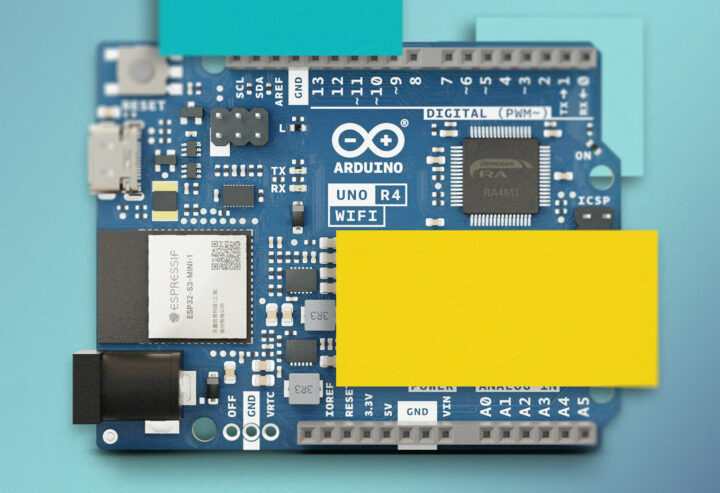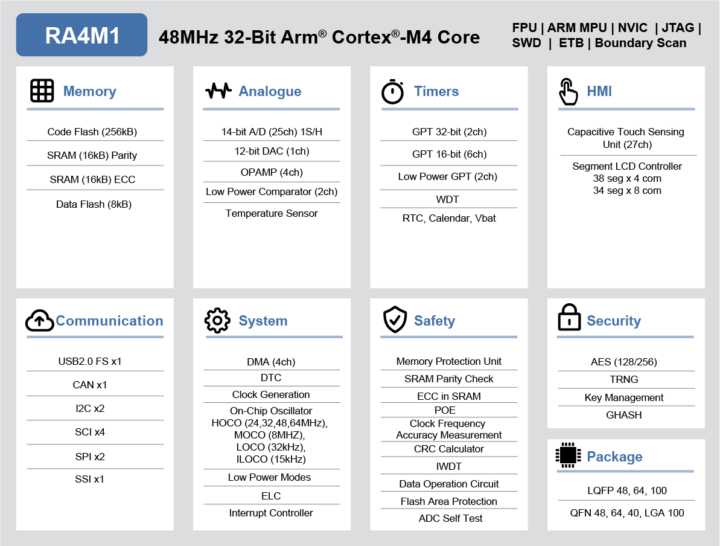Arduino have launched an upgrade to their 8-bit Arduino UNO R3 board with the Arduino UNO R4 featuring a 48 MHz Renesas RA4M1 Arm Cortex-M4F 32-bit microcontroller, and an optional ESP32-S3 module for WiFi 4 and Bluetooth 5.0 connectivity.
The new Arduino UNO R4 offered improved performance and greater resources since the MCU is clocked three times faster than the 8bit AVR MCU found in the UNO R3, the board gets sixteen times more RAM (32KB vs 2KB to 32kB) and eight times more flash memory (256KB vs 32kB). The USB Type-B device port has been upgraded to a more modern USB Type-C port and the UNO R4 can take up to 24V supply voltage.

Arduino UNO R4 (preliminary) specifications:
- Microcontroller – Renesas RA4M1 Arm Cortex-M4F MCU @ 48 MHz with 32KB SRAM, 256KB flash. 8KB dataflash
- Wireless (Arduino UNO R4 WiFi only) – ESP32-S3-MINI-1 module based on ESP32-S3 dual-core Xtensa LX7 microcontroller with 512KB SRAM, 384KB ROM, WiFi 4 and Bluetooth 5.0 connectivity, PCB antenna
- USB – 1 x USB Type-C port for power and programming
- Expansions – Arduino UNO headers with Pins
- 14x digital I/Os
- 13x LED pins
- Analog – 6x analog input pin, 12-bit analog DAC
- 6x PWM
- 6x UART, I2C, SPI
- CAN Bus support
- I/O Voltage – 5V
- DC Current per I/O pin – 20 mA
- Input voltage – 7 to 24V via a power barrel jack or Vin, 5V via USB-C port
- Dimensions – 68.6 x 53.4mm
- Weight – TBD

The new Arduino UNO R4 board also adds a CAN bus and a 12-bit analog DAC. Two versions of the new 32-bit Arduino UNO board will be offered: UNO R4 WiFi and UNO R4 Minima with the only difference being the former getting an ESP32-S3 module for wireless connectivity.
Arduino says pinout, voltage, and form factor are unchanged from UNO R3 in order to ensure maximum hardware and electrical compatibility with existing shields and projects. The company has also been working on retrocompatibility of the most popular Arduino libraries so that users can reuse existing sketches and tutorials developed for the UNO R3 on the UNO R4. This won’t be a problem in most cases, except for libraries and examples optimized for the AVR architecture (think assembly code) that will need to be ported to the new Renesas RA architecture.
It’s interesting to note that Arduino also switched to a Renesas MCU for their Portenta C33 board part of the Arduino Pro family for professional/business applications. But that does not necessarily means they’ll ditch Microchip MCUs in the future, and the Arduino UNO R3 is not going anywhere, with Arduino saying it will still be available and supported for makers who want to work with its 8-bit microcontroller.
The Arduino UNO R4 is scheduled for release in Late May at which point we’ll get the full features and pricing of the new 32-bit Arduino board, but if you have an Arduino library developer, you could get a sample earlier through the company’s early adaptor program. Typical users can join a waiting list on the main product page.
Via Arduino Blog where the board was unveiled for Arduino Day 2023.

Jean-Luc started CNX Software in 2010 as a part-time endeavor, before quitting his job as a software engineering manager, and starting to write daily news, and reviews full time later in 2011.
Support CNX Software! Donate via cryptocurrencies, become a Patron on Patreon, or purchase goods on Amazon or Aliexpress




